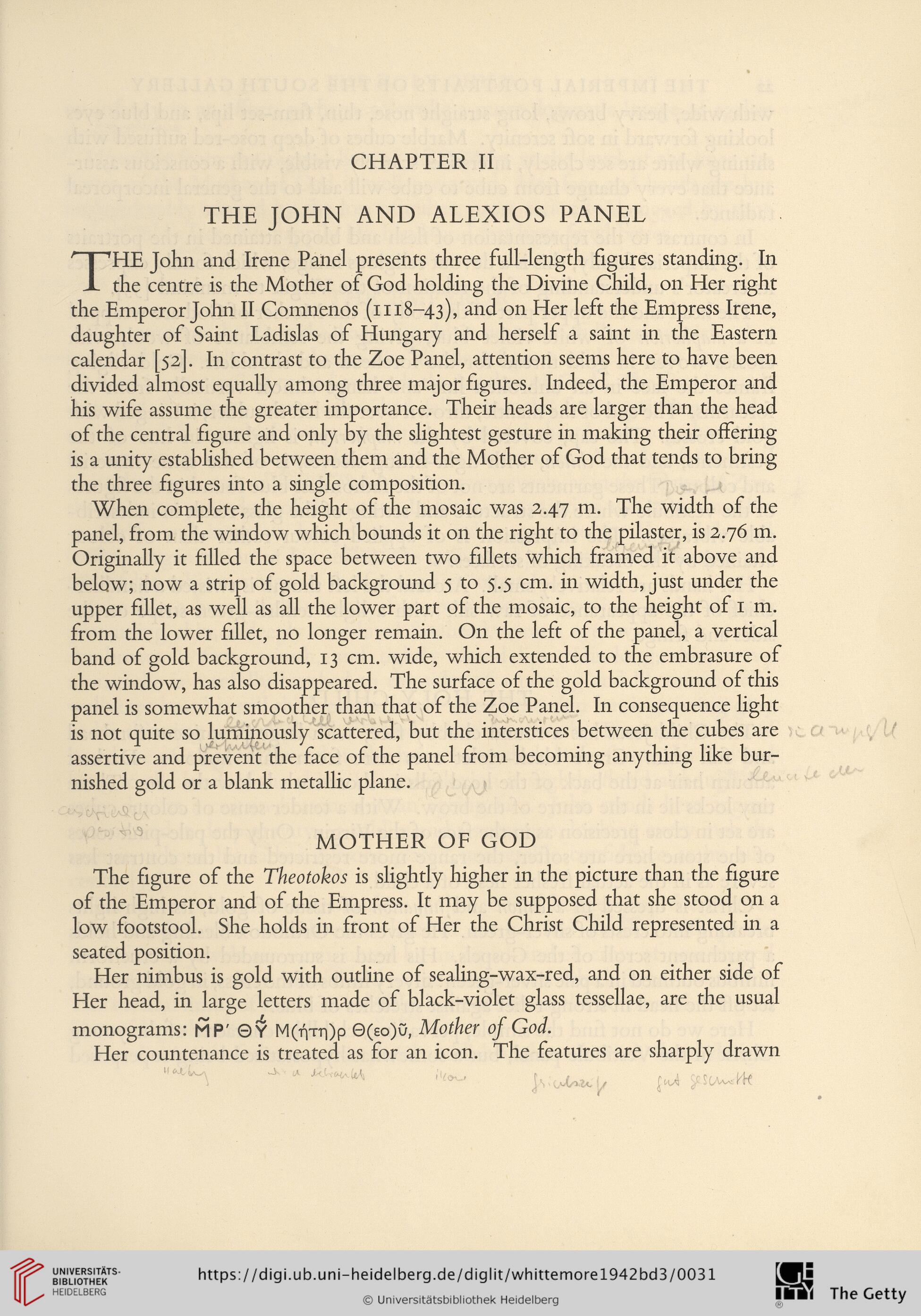CHAPTER II
THE JOHN AND ALEXIOS PANEL
r | ’HE John and Irene Panel presents three full-length figures standing. In
1 the centre is the Mother of God holding the Divine Child, on Her right
the Emperor John II Comnenos (1118-43), and 011 Her left the Empress Irene,
daughter of Saint Ladislas of Hungary and herself a saint in the Eastern
calendar [52]. In contrast to the Zoe Panel, attention seems here to have been
divided almost equally among three major figures. Indeed, the Emperor and
his wife assume the greater importance. Their heads are larger than the head
of the central figure and only by the slightest gesture in making their offering
is a unity established between them and the Mother of God that tends to bring
the three figures into a single composition.
When complete, the height of the mosaic was 2.47 m. The width of the
panel, from the window which bounds it on the right to the pilaster, is 2.76 m.
Originally it filled the space between two fillets which framed it above and
below; now a strip of gold background 5 to 5.5 cm. in width, just under the
upper fillet, as well as all the lower part of the mosaic, to the height of 1 m.
from the lower fillet, no longer remain. On the left of the panel, a vertical
band of gold background, 13 cm. wide, which extended to the embrasure of
the window, has also disappeared. The surface of the gold background of this
panel is somewhat smoother than that of the Zoe Panel. In consequence light
is not quite so luminously scattered, but the interstices between the cubes are
assertive and prevent the face of the panel from becoming anything like bur-
nished gold or a blank metallic plane.
MOTHER OF GOD
The figure of the Theotokos is slightly higher in the picture than the figure
of the Emperor and of the Empress. It may be supposed that she stood on a
low footstool. She holds in front of Her the Christ Child represented in a
seated position.
Her nimbus is gold with outline of sealing-wax-red, and on either side of
Her head, in large letters made of black-violet glass tessellae, are the usual
monograms: MP' OY M(t|tt|)p O(eo)u, Mother of God.
Her countenance is treated as for an icon. The features are sharply drawn
THE JOHN AND ALEXIOS PANEL
r | ’HE John and Irene Panel presents three full-length figures standing. In
1 the centre is the Mother of God holding the Divine Child, on Her right
the Emperor John II Comnenos (1118-43), and 011 Her left the Empress Irene,
daughter of Saint Ladislas of Hungary and herself a saint in the Eastern
calendar [52]. In contrast to the Zoe Panel, attention seems here to have been
divided almost equally among three major figures. Indeed, the Emperor and
his wife assume the greater importance. Their heads are larger than the head
of the central figure and only by the slightest gesture in making their offering
is a unity established between them and the Mother of God that tends to bring
the three figures into a single composition.
When complete, the height of the mosaic was 2.47 m. The width of the
panel, from the window which bounds it on the right to the pilaster, is 2.76 m.
Originally it filled the space between two fillets which framed it above and
below; now a strip of gold background 5 to 5.5 cm. in width, just under the
upper fillet, as well as all the lower part of the mosaic, to the height of 1 m.
from the lower fillet, no longer remain. On the left of the panel, a vertical
band of gold background, 13 cm. wide, which extended to the embrasure of
the window, has also disappeared. The surface of the gold background of this
panel is somewhat smoother than that of the Zoe Panel. In consequence light
is not quite so luminously scattered, but the interstices between the cubes are
assertive and prevent the face of the panel from becoming anything like bur-
nished gold or a blank metallic plane.
MOTHER OF GOD
The figure of the Theotokos is slightly higher in the picture than the figure
of the Emperor and of the Empress. It may be supposed that she stood on a
low footstool. She holds in front of Her the Christ Child represented in a
seated position.
Her nimbus is gold with outline of sealing-wax-red, and on either side of
Her head, in large letters made of black-violet glass tessellae, are the usual
monograms: MP' OY M(t|tt|)p O(eo)u, Mother of God.
Her countenance is treated as for an icon. The features are sharply drawn




